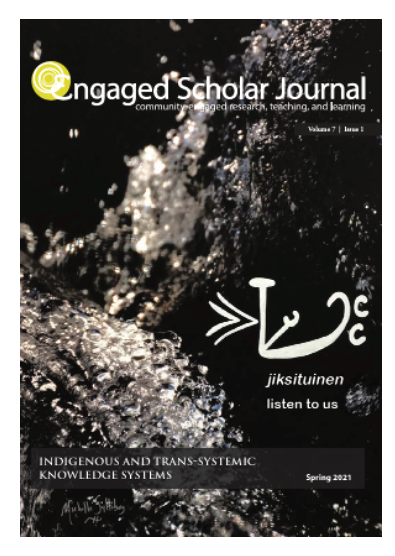Radical Acts of Re-imaging Ethical Relationality and Trans-systemic Transformation
DOI:
https://doi.org/10.15402/esj.v7i1.70759Keywords:
Indigenous knowledges, ethical relationality, Indigenous Métissage, Anishinaabe Ozihtoon, Indigenous knowledge practices, Indigenous ethics, reciprocal recognitionAbstract
This Indigenous métissage explores my engagement in Indigenous Arts-based Inquiry as a practice of Anishinaabe Ozihtoon or Indigenous making and knowledge generation. Anishinaabe Ozhitoon is a site that unlocks the theoretical potentialities of the intelligences within Indigenous Knowledge practices in contemporary contexts and reanimates Indigenous land-based assurgence. Reviving Indigenous artistic practices, as sites of co-imagining through constellations of co-creation, is part of ecological and community-based reconciliation and healing. Key to this process is the act of reciprocal recognition, a core practice that fosters ethical relationality, helps cultivate our Indigeneity, and honours the circle of life. This Indigenous métissage tracks the Indigenous pedagogical processes and Indigenous art making used in my own praxis and inquiry as a scholar while I worked in a university to create three pathways for trans-systemic knowledge creation: a university-wide President’s Dream Colloquium with an accompanying graduate course; a graduate diploma in Indigenous Education: Education for Reconciliation and a master’s in Indigenous Education: Truth, Reconciliation, and Indigenous Resurgence; and the Indigenous Research Institute initiation of an Indigenous Ethics Dialogue process as a trans-systemic pedagogical engagement with Indigenous and Western Knowledges, values, and ethics.
References
Absolon, K. E. (2011). Kaansossiwin: How we come to know. Fernwood Publishing.
Bartlett, C., Marshall, M., & Marshall, A. (2012). Two-Eyed Seeing and other lessons within a co-learning journey of bringing together Indigenous and mainstream knowledges and ways of knowing. Journal of Environmental Studies, 2, 331-340.
Battiste, M., & Henderson, J. Y. (2004). Protecting Indigenous knowledge and heritage: A global challenge. UBC Press and Purich Publishing.
Bohm, D., Factor, D., & Garrett, P. (1991). Dialogue – A Proposal. http://www.david-bohm.net/dialogue/dialogue_proposal.html
Brant-Castellano, M. (2000). Updating Aboriginal traditions of knowledge. In B. L. Hall, G. J. S. Dei, & D. G. Rosenberg (Eds.), Indigenous knowledges in global contexts: Multiple readings of the world (pp. 21-36). University of Toronto Press.
Cajete, G. (1994). Look to the mountain: An ecology of Indigenous education. Kivaki Press.
Cajete, G. (2015). Indigenous community: Rekindling the teachings of the Seventh Fire. Living Justice Press.
Donald, D. (2012). Indigenous Métissage: A decolonizing research sensibility. International Journal for Qualitative Studies in Education, 25(5), 335-355.
Ermine, W. (1995). Aboriginal Epistemology. In M. Battiste & J. Barman (Eds). First Nations education in Canada: The circle unfolds (pp. 101-112). UBC Press
Ermine, W. (2000). A critical examination of the ethics in research involving Indigenous peoples. M.Ed. Thesis. University of Saskatchewan.
Ermine, W. (2007). The ethical space of engagement. Indigenous Law Review, 6(1), 193-203.
Ermine, W., Sinclair, R., & Jeffery, B. (2004). The Ethics of research involving Indigenous Peoples. Report of the Indigenous Peoples Health Research Centre to the Interagency Advisory Panel of Research Ethics. http://iphrc.ca/pub/documents/ethics_review_iphrc.pdf
Iwama, M., Marshall, M., Marshall, A., & Bartlett, C. (2009). Two-eyed seeing and the language of healing in community-based research. Canadian Journal of Native Education, 32(2), 3-23.
Kelly, V. (2013a). Integrating Indigenous pedagogical practices. One World in Dialogue: Social Studies Council Journal, 2(2), 17-27.
Kelly, V. (2013b). In the discipline of the WIND. In W. Hurren & E. Hasebe-Ludt (Eds.), Contemplative curriculums (pp. 221-231). Routledge Books.
Kelly V. (2019) Ceremony as a Pathway to Reconciliation and Indigenous Resurgence. In: Peters M. (eds). Encyclopedia of Educational Philosophy and Theory. Springer. https://doi.org/10.1007/978-981-287-532-7_643-1
Kelly, V., & Rosehart, P. (2019). From reconciliation towards Indigenous cultural resurgence: A métissage on the co-imagining of Staʔəlnamət & Stel̓ númut. Canadian Journal of Native Education, 40(2), 59-84.
Hasebe-Ludt, E., Chambers, C., & Leggo, C. (2009). Life writing and literary Métissage: As an ethos for our times. Peter Lang.
Mueller, M. (2017). Being salmon being human: Encountering the wild in us and us in the wild. Chelsea Green Publishing.
Mish, F. (Ed.). (1990) Webster’s ninth new colligate dictionary. Thomas Allan & Sons.
Sheridan, J., & Longboat, R. H. C. t. S. D. (2006). The Haudenosaunee imagination and the ecology of the sacred. Space and Culture 9(4), 365–381.
Simpson, L. (2017). As we have always done: Indigenous freedom through radical resistance. University of Minnesota Press.
Smith, D. G. (1991). Hermeneutic inquiry: Hermeneutic imagination and the pedagogic text. In E. Short (Ed.), Forms of curriculum inquiry. SUNY Press.
Suzuki, D., & Knudtson, P. (2006). Wisdom of the elders: Native and scientific ways of knowing about nature. Greystone Books.
Wall Kimmerer, R. (2013). Braiding sweetgrass: Indigenous wisdom, scientific knowledge and the teachings of plants. Milkweed Editions.
Published
Issue
Section
License
Authors who publish with this journal agree to the following terms:
- Authors retain copyright and grant the journal right of first publication with the work simultaneously licensed under a Creative Commons Attribution License CC BY 4.0 that allows others to share the work with an acknowledgement of the work's authorship and initial publication in this journal.
- Authors are able to enter separate, additional contractual agreements for the non-exclusive distribution of the journal's published version of the work (e.g., post it to an institutional repository or publish it in a book), with an acknowledgement of its initial publication in this journal.
- Authors are permitted to post their work online (e.g., in an institutional repository or on their website) after the publication of their work in the Engaged Scholar Journal.
- Please note that while every opportunity will be taken to ensure author participation in the editing process, due to time constraints final copyediting changes may be made before publication to ensure APA adherence throughout all submissions.




